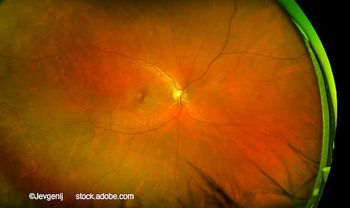
Tomographs best used as one of several sources
The retinal tomographer, a quantitative imaging instrument, is useful in both diagnosis and monitoring of ocular hypertension, suspected glaucoma, and early glaucoma.
Key Points
Atlanta-The tomograph (Heidelberg Retina Tomograph, Heidelberg Engineering) is a scanning laser ophthalmoscope that has moved out of research settings into widespread clinical use in glaucoma specialty practices.
Reports based on its quantitative measurements are helpful in diagnosis and patient monitoring, but the success of its use in patient management is based on factors such as image quality, the stage of disease, and the frequency of image acquisition, according to David Garway-Heath, MD, FRCOphth.
The tomograph is a useful diagnostic tool for patients with ocular hypertension and suspected glaucoma as well as a monitoring device for those two types of patients and those with early glaucoma. The tomograph output, however, should not be used in isolation but as one of several sources of information, said Dr. Garway-Heath during glaucoma subspecialty day at the annual meeting of the American Academy of Ophthalmology. He is Glaucoma Theme Lead at the National Institute for Health Research Biomedical Research Centre for Ophthalmology, Moorfields Eye Hospital and University College London Institute of Ophthalmology.
He described the tomograph and his use of this instrument in his practice. It provides monochromatic images and a surface height map or topography of the optic nerve head and peripapillary retina, scaled for the magnification characteristics of the eye. The topography enables quantitative measurements of the nerve structure to be made. In addition, follow-up images can be compared with those taken at baseline to identify progressive glaucomatous damage.
To obtain high-quality images, which are essential for correct data interpretation, technician training and quality control are essential, according to Dr. Garway-Heath, who noted that technician training is available online at the manufacturer's Web site. The training should incorporate techniques to optimize image quality, such as performing imaging before tonometry, using artificial tears in dry eyes, or dilating the pupil in eyes with cataract. Otherwise, it is preferable to obtain the image through an undilated pupil.
Quality control measures include taking multiple images and selecting the highest quality for analysis, determining whether any features in the image would confound the software analysis, and checking that the disc margin contour or edge has been correctly placed.
The next step in data interpretation is to determine whether a valid test has been performed. The technician and clinician should look for any confounding factors that might affect the test quality and determine the appropriateness of the subject to the normative database. Some subjects may be poor matches because an exceptionally high refractive error, large disc size, or if their ethnic origin is not reflected in the normative data, Dr. Garway-Heath explained. In such instances, caution is warranted in interpreting the test.
Clinicians also should keep the data in perspective.
"I want to emphasize that the machines do not produce a diagnosis. They produce a statistical classification. Clinicians using the machines should try to think in terms of probabilities rather than a binary diagnosis," Dr. Garway-Heath said. "They should use the report from the instrument either to increase or to reduce the probability that glaucoma is present."
An adaptation of Bayes' theorem may be used as well in making the diagnosis. In what is known as Fagan's nomogram, the probability that glaucoma is present is considered before doing a diagnostic test. The likelihood ratio is used to calculate the post-test probability that a patient has glaucoma. The tomograph also is very helpful in measuring optic disc progression and may be more accurate for this task than for diagnosis, Dr. Garway-Heath continued. To ensure best results, a high-quality baseline must be acquired.
Once a series of scans has been obtained, the series should be reviewed, starting with the baseline. If it is of poor quality, choose another one, he said.
Similarly, poor-quality images within the series may need to be excluded occasionally. The disc margin contour margin should be checked, as should the alignment of images to baseline.
The software supports identification of progression by identifying groups of pixels in the image in which the surface height at follow-up is significantly lower when compared with the baseline image. The software automatically identifies a cluster of these pixels when they reach a significant size, then plots the size and volume of change over time. The visual display of these data is helpful in assessing whether the optic nerve head is stable or progressing, Dr. Garway-Heath said.
No hard data are available on how frequently the tomograph should be used for monitoring. Dr. Garway-Heath, however, suggested that imaging should be performed at a frequency similar to visual field testing, with the timing guided by risk factors. Eyes at high risk should be tested every 4 months for the first 2 years, patients at moderate risk should be tested every 6 months, and those at low risk should be tested yearly, he said.
He also recommended that both visual field testing and imaging be performed in eyes with ocular hypertension or early glaucoma to pick up all instances of progression.
Newsletter
Don’t miss out—get Ophthalmology Times updates on the latest clinical advancements and expert interviews, straight to your inbox.



















































.png)


